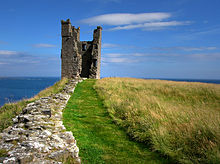Lilburn family
| Lilburn | |
|---|---|
 | |
| Country | Kingdom of England, United Kingdom |
The Lilburns are a family originating in Northumberland, United Kingdom.[citation needed] The family name Lilburn (variations include Lilburne, Lilbourn and Lilbourne) derives from the original home of the family, Lilburn, Northumberland.[1]
Coat of arms[]


The heraldic blason for the Lilburn coat of arms is a cendree (or sable[2]) field, with three bougets argent.[3][4]
Family history[]
The Lilburn family can be traced back to Lilburn, Northumberland.[5] The Lilburn family name can be found carved into ancient gravestones in the vicinity of West Lilburn Tower, Lilburn, and Lindisfarne (Holy Island), near the medieval priory.[6] In a 14th-century church's graveyard, near West Lilburn Tower, a number of tombs allegedly belong to the Knights Templar, among which some bear the Lilburn name.[7]
In the 17th century John Lilburne and most of his family were key figures in the English Civil Wars (see Prominent members). In his day, the family was noted to be "typical of the lesser gentry in the northern counties: its members often dull and uninspired, sitting in Parliament but saying little, engaging in the minutiae of local magisterial and commercial disputes." His father Richard held "a modest manorial holding" at Thickley Punchardon, near Bishop Auckland.[8][9]
Prominent members[]


- Sir John de Lilburn (1279-1355) was son of Idonea de Vieuxpont (or Vipont) (1255-1333), daughter of Robert de Vieuxpont, II Baron of Westmoreland; Idonea owned Pendragon Castle and founded St Mary's Outhgill in Mallerstang, Cumbria.[10] The identity of his father is uncertain: evidence in a pedigree following visitations in 1575, 1615 and 1666 indicates him to have been William de Lilburn; other genealogical documentation from Northumberland, studying the family from the Vieuxpont side, shows that Sir John de Lilburn could be the son of a Roger (or Robert) de Leybourne.[11][12] Sir John was the nephew and heir of Christine de Lilburn, through whom he inherited “livery of the manor of Lilburn as one knight’s fee” on October 26, 1324. He was knighted at the King’s Court at Christmas 1315 and a few months after was appointed Constable of Mitford Castle. He was appointed Constable of Dunstanburgh Castle in 1323, where the famous Lilburn tower was named after him, part of which is still standing. He was Commissioner of Array in Northumberland in 1325 and sheriff of Northumberland in from 1327 to 1329. Sir John married Lady Constance de Lilburn (1298-1366) in 1319.[citation needed] From his second marriage, to Lady Beatrice de Beauchamp (1280-1347), was born a son, John, in 1328.[citation needed]
- John Lilburne (1614-1657), or John Freeborn, grandson of the above, was a political Leveller and one of the leading figures of the English Civil Wars
- Robert Lilburne (1613–1665), English soldier, brother of the above John Lilburne, signatory to the death warrant of King Charles I in 1649[13]
The actor Tom Goodman-Hill, who played John Lilburne in Channel 4's drama The Devil's Whore, is a sixteenth-generation descendant of John Lilburn's uncle, Joseph.[citation needed]
See also[]
References[]
- ^ A Dictionary of English Surnames, Percy Hide Reaney, W. A. F. Browne, Richard Middlewood Wilson, Routledge, 1991, p. 1955
- ^ "Archived copy". Archived from the original on 2015-06-19. Retrieved 2015-06-19.CS1 maint: archived copy as title (link)
- ^ John Lilburne, the Leveller, a Christian Democrat, Mildred A. Gibb, L. Drummond, 1967, p. 20
- ^ The Proceedings of the Society of Antiquaries of Newcastle upon Tyne, 1925, p. 21
- ^ A Dictionary of English Surnames, Percy Hide Reaney, W. A. F. Browne, Richard Middlewood Wilson, Routledge, 1991, p. 1955
- ^ Mackenzie, Eneas (1825). An Historical, Topographical and Descriptive View of the County of Northumberland, Vol. II, pp. 14-15. Newcastle upon Tyne: Mackenzie and Dent.
- ^ "Archived copy". Archived from the original on 2015-06-10. Retrieved 2015-06-09.CS1 maint: archived copy as title (link)
- ^ John Lilburne, the Leveller, a Christian Democrat, Mildred A. Gibb, L. Drummond, 1967, p. 20
- ^ https://www.oxforddnb.com/view/10.1093/ref:odnb/9780198614128.001.0001/odnb-9780198614128-e-16654?rskey=fnQss2&result=2
- ^ Nicolson, Joseph; Burn, Richard (1777). W. Strahan y T. Cadell (ed.). The history and antiquities of the counties of Westmorland and Cumberland. Londres.
- ^ http://www.vieuxpont.co.uk/imagelib/sitebuilder/misc/show_image.html?linkedwidth=actual&linkpath=http://vieuxpont.co.uk/sitebuildercontent/sitebuilderpictures/Vieuxpontpedigre.jpg&target=tlx_new
- ^ Sanders, I.J. English Baronies: A Study of their Origin & Descent 1086-1327, Oxford, 1960. pp.103-4, Appleby, pp23-24, Burgh-by_Sands.
- ^ Andrew Bisset History of the Commonwealth of England – From the Death of Charles I. to the Expulsion of the Long Parliament
- English families